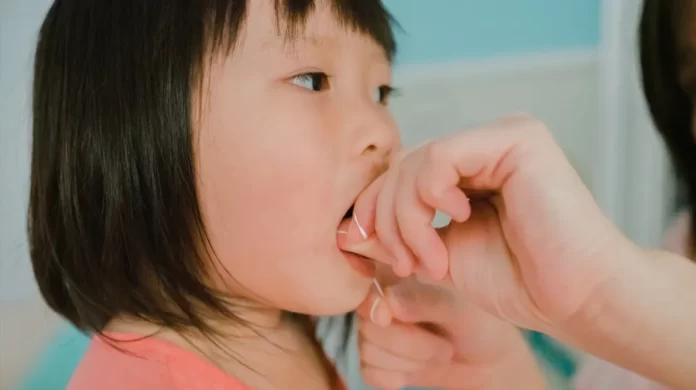About 40% of children in the United States experience tooth decay known as dental caries by age 19.
The factors behind this trend include lower household income, lack of access to insurance, and language barriers that prevent many families from accessing proper care at a dentist’s office.
But it doesn’t have to be this way, suggests the American Academy of Pediatrics (AAP) with their release of updated recommendations for children’s oral health.
“Pediatricians can help parents learn to prevent tooth decay in their children from the time they are infants, even before the first tiny teeth emerge,” says Dr. David Krol, MPH, FAAP, the lead author of the report and the medical director of Connecticut Children’s Care Network, in the AAP press release.
“Families can instill good habits early by never putting a child to bed with a bottle, avoiding sugary drinks, and serving as role models by brushing and flossing regularly,” he adds.
New guideline key points for parents
The key takeaways for parents from the AAP report include actions that can be taken to help reduce tooth decay risk in children.
The report recommends:
- Children have a dentist by age 1.
- They drink fluoridated tap water between meals.
- They avoid juice intake before age 1.
- Children between ages 1 and 3 consume, at most, 4 ounces or half a cup of juice per day.
- Children ages 4 to 6 limit juice consumption to around 4 to 6 ounces per day.
- During ages 7 to 18 years, juice intake should be limited to 8 ounces or 1 cup of the recommended 2 to 2.5 cups of fruit servings per day.
Benefits of fluoridated water for dental health
The researchers recommend fluoridated tap water over bottled water when it comes to dental health because fluoride helps prevent tooth decay and cavities.
“Most bottled waters do not contain an adequate amount of fluoride,” said Dr. Kaitlin Whelan, FAAP, the co-author of the report and a pediatrician with Peak Pediatrics in Colorado, in the press release.
“Fluoride toothpaste and rinses are helpful, and the pediatrician or dentist can also apply fluoride varnish to the teeth two to four times annually, a practice that we know reduces substantially the risks of dental caries,” she added.
“Fluoride Use in Caries Prevention in the Primary Care Setting” created by the AAP provides more information about fluoride and dental health.
The AAP added updated recommendations for pediatricians, too.
They include:
- Assess children’s oral health and any potential oral health risks.
- Provide guidance in oral health care (e.g., Use a smear or a grain-of-rice-sized amount of fluoride toothpaste, increasing to a pea-sized amount when a child reaches age 3).
- Counsel parents, caregivers, and patients (where appropriate) on ways to cut back on sugary drinks and foods.
- Encourage caregivers to brush the child’s teeth at least twice a day starting as soon as teeth erupt.
- Advise parents and caregivers to help with and/or monitor brushing until a child turns 10.
Additional resource for parents at HealthyChildren.org: Good Oral Health Starts Early: AAP Policy Explained
What dentists have to say
“Establishing pediatricians as a source of information for children’s dental health is a big step toward the prevention of dental caries AKA cavities in children,” explained Dr. Richard M. Lipari, DDS, who is an active member of the American Academy of Facial Aesthetics and the American Academy of Cosmetic Dentistry.
Lipari says many parents may not be proactive in finding a dentist or are unsure of the appropriate age to begin seeing a dentist.
While creating a connection with a dentist around age 1 is advised by the AAP, Lipari says that children should have their first appointment with a dentist usually right around 3 years old.
He adds that children begin getting permanent teeth or “adult teeth” at about 6 years old and those teeth need to last them a lifetime.
Next steps for parents of younger children
Dr. Kami Hoss, DDS, the co-founder of The Super Dentists and author of If Your Mouth Could Talk, offers the following tips for parents so their children develop healthy oral care habits:
Safety must always be a priority
“The ingredients in oral care products can get absorbed through the soft tissues and mucous membranes in the mouth and from there they can travel throughout the body,” he told Healthline.
“Children also tend to swallow more toothpaste and mouthwash than adults,” he adds. “Therefore parents need to educate themselves about the ingredients in oral care products.”
You can try asking your pediatrician or dentist for their recommendation if you’re not sure which is most appropriate.
Is it effective?
“There is more to oral care products than just fluoride vs non-fluoride or manual vs electric toothbrush,” says Hoss.
“Parents should select their children’s oral care products based on their age, risk factors (history of cavities, diet, etc.), and individualized preferences,” he says.
Are you having some fun?
Our psychological association with oral care forms when we are young, says Hoss.
“So it’s important that children participate in picking out products that they love so they enjoy taking care of their mouths and build positive associations with oral care,” he said.
“From musical toothbrushes to flavored toothpaste and more, every child should be able to find the products that are just right for them,” Hoss added.
Practice what you preach
“It’s not only important to be a good role model for your children, but when it comes to oral care, the oral microbiome from all caregivers can be transferred to the child,” says Hoss.
In other words, taking care of your own mouth is one good way to take care of your child.
Participate in their oral care routine
While the AAP guidelines recommend supervision and assisting your children with their oral care until they’re 10, Hoss explains many children require supervision for brushing and particularly flossing longer than that.
